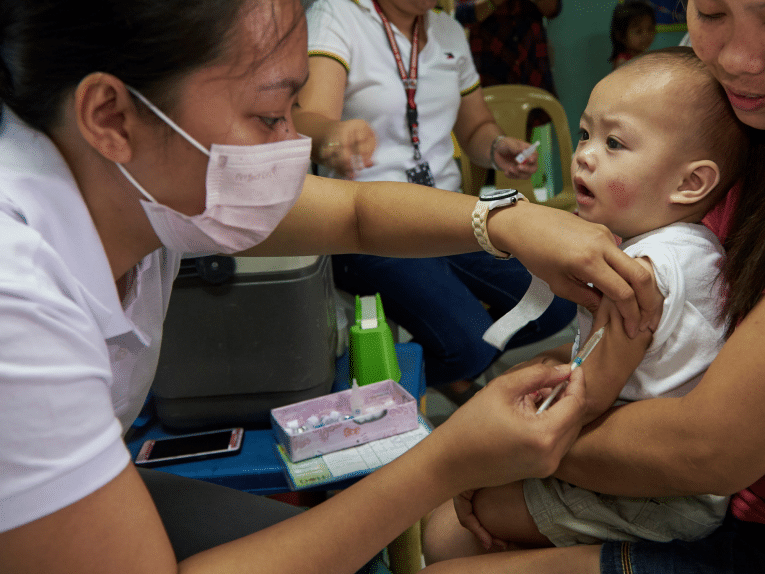MEASLES is a highly contagious but easily preventable disease. A two-dose vaccine can save people, especially children, from its adverse effects that could include death.
However, the COVID-19 pandemic has led to fewer measles vaccinations worldwide, and the World Health Organization and the US Centers for Disease Control have warned that it is now an “imminent” global threat.
They said some 40 million children are vulnerable to infection after they failed to get a vaccine or to complete the two-dose regimen.
The Philippines is one of the countries that had a lower measles vaccination rate due to the pandemic, according to reports quoting the Department of Health.
The DOH said in early October that measles cases were 153 percent higher than those reported in 2021.
It also said at that time that almost three million children had not been vaccinated against measles, and attributed it to the disruptions resulting from pandemic restrictions and the parents’ hesitancy.
If the vaccine coverage of children does not improve, the Philippines may face a measles outbreak by 2023, DOH Officer in charge Maria Rosario Vergeire warned.
Alarming numbers worldwide
In 2021, close to 40 million children worldwide missed a measles vaccine dose, with 25 million missing their first dose and 14.7 million failing to get their second dose, the WHO and CDC said in their joint statement.
This was a significant setback for efforts to eliminate measles, they said.
This decline, along with weakened surveillance, disruptions in immunization efforts, and large outbreaks in some areas mean “measles is an imminent threat in every region of the world.”
“The paradox of the pandemic is that while vaccines against COVID-19 were developed in record time and deployed in the largest vaccination campaign in history, routine immunization programmes were badly disrupted, and millions of kids missed out on life-saving vaccinations against deadly diseases like measles,” said WHO Director-General Dr Tedros Adhanom Ghebreyesus.
Ghebreyesus stressed the need to resume immunization activities for this disease.
“Behind every statistic in this report is a child at risk of a preventable disease,” he said.
According to the health experts, 95 percent coverage or more of two doses of the measles-containing vaccine is needed to create herd immunity. This would protect communities and help in the elimination of measles.
But the WHO and CDC said only 81 percent of children have received their first measles-containing vaccine dose, and only 71 percent have received the second dose.
“These are the lowest global coverage rates of the first dose of measles vaccination since 2008, although coverage varies by country,” they said.
They called for urgent global action, as “measles anywhere is a threat everywhere, as the virus can quickly spread to multiple communities and across international borders.”
They noted that since 2016, 10 countries that had eliminated measles had outbreaks of the disease.
Delays in immunization programs could lead to more outbreaks, they warned.
Other health experts also weighed in and stressed the need for urgent action to save lives, especially those of children.
“We have a short window of opportunity to urgently make up for lost ground in measles vaccination and protect every child. The time for decisive action is now,” said Ephrem Tekle Lemango, UNICEF Chief of Immunization.
What is measles?
Measles is a highly contagious respiratory disease caused by a virus in the paramyxovirus family, which normally grows in the cells that line the back of the throat and lungs, according to the DOH.
It is transmitted from person to person by sneezing, coughing, and close personal contact.
The signs and symptoms of the disease are a blotchy rash that lasts for more than three days, cough, runny nose, red eyes, and fever.
It could also cause complications, such as diarrhea, middle ear infection, pneumonia, encephalitis, malnutrition, and blindness.
The WHO said most measles-related deaths are due to complications associated with the disease, and serious complications are more common in children under the age of 5, or adults over the age of 30.
It also said severe measles is more likely among poorly nourished young children, especially those with insufficient vitamin A, or who have weakened immune systems.
Unvaccinated most at risk
The WHO said unvaccinated young children are at highest risk of measles and its complications, which could include death.
Also at risk are unvaccinated pregnant women and a non-immune person who has not been vaccinated or was vaccinated but did not develop immunity, it said.
It also said measles outbreaks could be deadly in countries experiencing or recovering from a natural disaster or conflict because disruptions in health services interrupt routine immunization, and overcrowding in evacuation centers increases infection risk.
How is it treated?
The WHO said there is no specific antiviral treatment for the measles virus, but its complications could be reduced.
Those infected should be given nutritional support and oral rehydration to strengthen their bodies and replace lost fluids.
They could also take antibiotics prescribed by physicians to treat infections.
Children diagnosed with measles should receive two doses of vitamin A supplements, given 24 hours apart.
Photo credit: Unicef








